| Solution | NOTE Icons used on this page: <  >: Movie Shooting / <  >: Cross keys /  ]: Live View Shooting /  : Movie Tab 1 / <  >: Quick Control button / <  >: Live View shooting / Movie shooting button /  (face)+Tracking]: (face)+TrackingAF /  ] [  ]  ]  ]: AF point / <  >: Setting button / <  >: Erase button / <  >: Magnify button / <  >: Reduce button / <  >: Set-up Tab 2 / <  >: Shooting Tab 2 *The icons and markings indicating the cameras buttons, dials, and settings correspond to the icons and markings on the camera and on the LCD monitor.
With your camera, you can shoot photos while viewing the image on the camera's LCD monitor. This is called "Live View shooting". This page describes how to change the focus mode for Live View shooting. For details on how to perform easy Live View shooting in default settings, please refer to the related information. Please note that some shooting procedures differ between still photos and movies. To shoot still photos, please refer to the instructions for still photos, and to shoot movies, please refer to the instructions for movies. Part I. Preparing for Live View Shooting 1. 1. Turn the camera's power switch to <ON>. 2. Turn the Mode Dial to set the shooting mode. To use AF to focus, please proceed to Part II. To focus manually, please proceed to Part III . Part II, and III describe common procedures for still photos and movies. You can shoot also using the shutter button in all shooting modes. For details, see the instruction manual supplied with the camera. Part II. Selecting the AF Method 3. Set the lens focus mode switch to <AF>.  4. Make sure that the camera is ready to take shots, and then press the <MENU> button.  5. Press the <  > keys to select tabs on the MENU screen. - To shoot still photos, select the [
 ] tab, and then select [Enable] in the [Live View shoot.] option. ] tab, and then select [Enable] in the [Live View shoot.] option. - To shoot movies, select the [
 ] tab. ] tab.
 6. Select the [AF method], and then press <  >.  7. Select the AF method, and then press <  >.  NOTE While the image is displayed on the LCD monitor, pressing the <  > button will enable you to set the AF method etc. on the Quick Control Screen. For more information, please refer to the instruction manuals that came with your camera.
8. Select the image-recording quality for still images or the movie-recording size for movies. - For still images, select [Image quality] from the [
 ] tab, press < ] tab, press < > button, and then select the recording size from the screen that appears. > button, and then select the recording size from the screen that appears. - For movies, select [Movie rec. size] from the [
 ] tab, press the < ] tab, press the < > button, and then select the recording size from the screen that appears. > button, and then select the recording size from the screen that appears.
For more information about the image quality of still images and the recording size of movies, please refer to the instruction manuals that came with your camera. 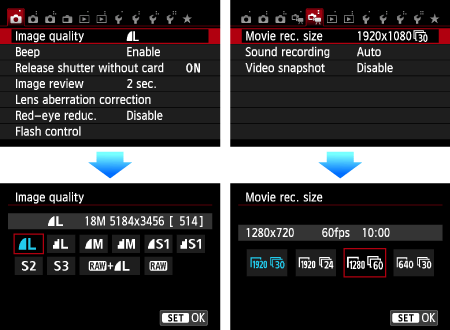 9. To shoot still photos, press the <  > button, or to shoot movies, press the <MENU> button, and then close the menu window. An image will appear on the LCD monitor.  As the next step may differ depending on the AF method setting, Please confirm your AF mode setting before proceeding. Part II-1 Using AF (Face+Tracking) to Focus
Part II-2. AF Using AF (FlexiZone - Multi) to Focus
Part II-3. Using AF (FlexiZone - Single) to Focus
Part II-4. Using AF (Quick Mode) to Focus
Part II-1 Using AF (Face+Tracking) to Focus When [  (face)+Tracking ] is set: Human faces are detected and focused. If a face moves, the AF point <  > also moves to track the face.  10. The subject's face is focused. - When a face is detected, the [
 ] AF point will appear over the face to be focused. ] AF point will appear over the face to be focused. - If multiple faces are detected, [
 ] will be displayed. Press the < ] will be displayed. Press the < > key to move the [ > key to move the [  ] frame over the desired target face. ] frame over the desired target face. - You can also tap the LCD monitor screen to select the face or subject. If the subject is not a face,
 ] will be displayed. ] will be displayed. - If the face is not detected or the face or subject is not selected when you touch the screen, the camera switches to 31-point auto selection for Flexi-Zone Multi.
 11. Press the shutter button halfway to focus the [  ] face.  - When focus is achieved, the AF point will turn green and the beeper will sound.
- If focus is not achieved, the AF point will turn orange.
IMPORTANT - At this point the camera has only achieved focus and a picture will not be taken. To take a picture, follow the procedure in Part IV.
- If the focus is far off, face detection will not be possible. If you set [Continuous AF] to [Enable], you can prevent the image from becoming greatly out of focus.
- An object other than a human face may be detected as a face.
- Face detection will not work if the face is very small or large in the picture, too bright or too dark, or partially hidden.
- The [
 ] may cover only part of the face. ] may cover only part of the face.
NOTE If you press <  > or the <  button, the AF point <  > will appear at the center and you can use the <  > keys to move the AF point. Pressing <  > or <  > again will move the AF Frame to a detected subject. - Since AF is not possible with a face detected near the edge of the picture, the <
 > will be grayed out. If you press the shutter button halfway, the subject will be focused in FlexiZone - Multi method with automatic selection. > will be grayed out. If you press the shutter button halfway, the subject will be focused in FlexiZone - Multi method with automatic selection.
REFERENCE When [Continuous AF] or [Movie servo AF] is set to [Enable] - When [
 +Tracking] FlexiZone - Multi] with automatic selection is set, the AF point will be momentarily displayed in the image center if the subject is not detected. If you press the shutter button halfway, the camera will focus in FlexiZone - Multi method with automatic selection. If you press the shutter button halfway during movie shooting, the center AF point will be used to focus. +Tracking] FlexiZone - Multi] with automatic selection is set, the AF point will be momentarily displayed in the image center if the subject is not detected. If you press the shutter button halfway, the camera will focus in FlexiZone - Multi method with automatic selection. If you press the shutter button halfway during movie shooting, the center AF point will be used to focus.
Proceed to Part IV.
Part II-2. AF Using AF (FlexiZone - Multi) to Focus [FlexiZone - Multi] is an AF method that makes it easy to focus a moving subject. Up to 31 AF points (automatically selected) covering a wide area can be used to focus (31-point auto selection). This wide area can also be divided into 9 zones for focusing (zone selection).  10. Select the AF zone. - When you press the <
 > or < > or < > button, you switch between 31-point automatic selection and zone selection. In Basic Zone modes, automatic selection is set automatically. > button, you switch between 31-point automatic selection and zone selection. In Basic Zone modes, automatic selection is set automatically. - In zone selection, select the zone with the <
 > keys. To return to the center zone, press < > keys. To return to the center zone, press < > or the < > or the < > button again. > button again. - You can also tap the LCD monitor screen to select a zone. When a zone is selected, tap [
 ] on the screen to switch to automatic selection. ] on the screen to switch to automatic selection.
 11. Aim the AF point over the subject and press the shutter button halfway.  - When focus is achieved, the AF point will turn green and the beeper will sound.
- If focus is not achieved, the area frame will turn orange.
IMPORTANT At this point the camera has only achieved focus and a picture will not be taken. To take a picture, follow the procedure in Part IV.
NOTE Notes on Shooting in [FlexiZone - Multi] - When the camera does not focus the desired target subject with automatic AF point selection, switch the AF method to zone selection or [FlexiZone - Single], and refocus.
- Depending on the aspect ratio setting, the number of AF points will differ. At [3:2], there will be 31 AF points. At [1:1] and [4:3], there will be 25 AF points. At [16:9], 21 AF points. Also, at [16:9], there will be only three zones.
- For movie shooting, there will be 21 AF points (or 25 AF points if [640x480] is set) and three zones (or 9 zones if [640x480] is set).
Proceed to Part IV.
Part II-3. Using AF (FlexiZone - Single) to Focus When [FlexiZone - Single] is set: Since only one AF point is used to focus, you can focus the target subject.  10. The AF point <  > will appear. During movie shooting, if [Movie servo AF] is set to [Enable], the AF point will be displayed in a larger size. 11. Move the AF point. - Press the <
 > key to move the AF point to where you want to focus. (It > key to move the AF point to where you want to focus. (It
cannot be moved to the edges of the picture.) - To return the AF point to the center, press <
 > or the < > or the < > button. > button. - You can also tap the LCD monitor screen to move the AF point.
 12. Aim the AF point over the subject and press the shutter button halfway.  - When focus is achieved, the AF point will turn green and the beeper will sound.
- If focus is not achieved, the AF point will turn orange.
IMPORTANT At this point the camera has only achieved focus and a picture will not be taken. To take a picture, follow the procedure in Part IV.
Proceed to Part IV.
Part II-4. Using AF (Quick Mode) to Focus When [Quick Mode] is set: The dedicated AF sensor is used to focus in One-Shot AF operation, using the same AF method as with viewfinder shooting. You can use nine AF points to focus (9-point automatic selection). You can also select one AF point to focus and focus only the area covered by that AF point (manually selected). Although you can focus the target subject quickly, the Live View image will be interrupted momentarily during the AF operation.  10. The small boxes inside the screen are the AF points. 11. Select the AF point. - Pressing <
 > or the < > or the < > button will toggle between automatic selection and manual selection. In Basic Zone modes, automatic selection is set automatically. > button will toggle between automatic selection and manual selection. In Basic Zone modes, automatic selection is set automatically. - Set the desired selection state and press the <
 > keys to set the focus to the selected AF point. To return the AF point to the center, press < > keys to set the focus to the selected AF point. To return the AF point to the center, press < > or the < > or the < > button. > button. - You can also tap the LCD monitor screen to select the AF point. During manual selection, tap [
 ] on the screen to switch to automatic selection. ] on the screen to switch to automatic selection.
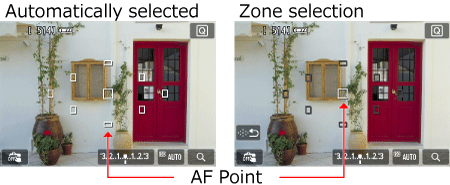 13. Aim the AF point over the subject and press the shutter button halfway. (Hold the button.)  14. The Live View image will turn off, the reflex mirror will go back down, and AF will be executed. (No picture is taken.) - When focus is achieved, the AF point that achieved focus will turn green and the Live View image will reappear.
- If focus is not achieved, the AF point will turn orange and blink.
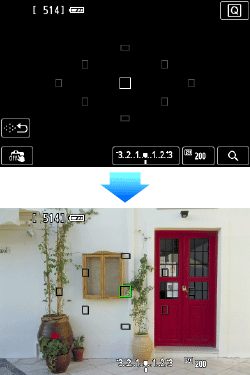 IMPORTANT At this point the camera has only achieved focus and a picture will not be taken. To take a picture, follow the procedure in Part IV.
NOTE - When [Quick mode] is set, [Continuous AF] cannot be set.
- The [Quick mode] cannot be set for movie shooting.
- You cannot take a picture during autofocusing. Take the picture while the Live View image is displayed.
Proceed to Part IV.
Part III. Focusing Manually You can magnify the image and focus precisely manually. 3. Once you have completed the procedure up to Step 2 of Part I, set the lens focus mode switch to <MF>. 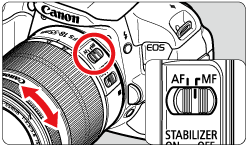 4. To shoot still photos, make sure that the camera is ready to take shots, and then press the <  >(Live View shooting) button.  5. The Live View image will appear on the LCD monitor. Turn the lens focusing ring to focus roughly. 6. Press <  > to display the magnifying frame. You can also tap  ] on the screen to magnify the image. 7. Press the <  > key to move the magnifying frame to the position where you want to focus. To return the magnifying frame to the center, press <  > or the <  > button.  8. Press the <  > button to magnify the area within the frame. 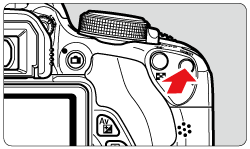 Each time you press the <  > button, the magnification within the frame will change as follows: Normal view -> Approx. 5x -> Approx. 10x -> Normal view 9. While looking at the Live View image on the LCD monitor, turn the focusing ring to focus manually. 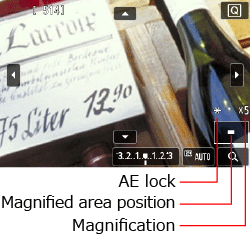 10. After achieving focus, press the <  > button to check the image composition in normal view.
Part IV. Shooting After focus is achieved by following the instructions in Part II-III, start shooting. To shoot still photos, press the shutter button completely. - The picture will be taken and the captured image is displayed on the LCD monitor.
- After the image review ends, the camera will return to Live View shooting automatically.
To shoot movies, press <  >. - To stop shooting the movie, press <
 > again. > again. - While the movie is being shot, the "
 " mark will be displayed on the upper right of the screen. " mark will be displayed on the upper right of the screen.

General Note for Live View Shooting Please be aware of the following notes for Live View shooting. IMPORTANT Notes about the Live View Image - Under low or bright light conditions, the Live View image might not reflect the brightness of the captured image.
- If the light source within the image changes, the screen might flicker. If this happens, stop and resume the Live View shooting under the actual light source to be used.
- If you point the camera in a different direction, it might throw off the Live View image's correct brightness momentarily. Wait until the brightness level stabilizes before shooting.
- If there is a very bright light source in the picture, the bright area might appear black on the LCD monitor. However, the actual captured image will correctly show the bright area.
- In low light, if you set the
 : LCD brightness] to a bright setting, : LCD brightness] to a bright setting,
chrominance noise may appear in the Live View image. However, the chrominance noise will not be recorded in the captured image. - When you magnify the image, the image sharpness may look more pronounced than in the actual image.
Custom Functions - During Live View shooting, certain Custom Function settings will not take effect.
For more information on Custom Function settings, refer to the Instruction Manual. Lens and Flash - The focus preset function is possible for Live View shooting only when using a (super) telephoto lens equipped with the focus preset mode marketed since the second half of 2011.
- FE lock is not possible when the built-in flash or an external Speedlite is used. Modeling flash will not work with an external Speedlite.
White <[  ]> and Red <[  ]> Temperature Warning If the cameras temperature increases due to prolonged Live View shooting or under a high ambient temperature, a white icon <[  ]> will appear. If you continue shooting while this icon is displayed, the image quality of still photos may deteriorate. It is recommended to temporarily exit Live View shooting and allow the camera to cool down before shooting again. If the cameras temperature further increases while the white icon <[  ]> is displayed, a red icon <[  ]> will start blinking. This blinking icon indicates that the Live View shooting will soon stop automatically. If this happens, you will not be able to shoot again until the cameras temperature decreases. Turn off the power and let the camera rest for a while. Using Live View shooting at a high temperature for a prolonged period will cause the <[  ]> and <[  ]> icons to appear earlier. When you are not shooting, turn off the camera. If the cameras temperature is high, the image quality of high ISO speed images or long exposures may be degraded even before the white icon <[  ]> is displayed. Shooting Result If you take the picture in magnified view, the exposure may not come out as desired. Return to the normal view before taking the picture. In magnified view, the shutter speed and aperture will be displayed in orange. Even if you take the picture in magnified view, the image will be captured in the normal view. If [  : Auto Lighting Optimizer] is not set to [Disable], the image may look bright even if a decreased exposure compensation or decreased flash exposure compensation is set. If you use a TS-E lens (other than the TS-E17mm f/4L or TS-E24mm f/3.5L II) and shift or tilt the lens or use an Extension Tube, the standard exposure may not be obtained or an irregular exposure may result. Notes About [  +Tracking], [FlexiZone - Multi], and [FlexiZone - Single] - Focusing will take longer than with [Quick mode].
- Even when focus has been achieved, pressing the shutter button halfway will focus again.
- The image brightness may change during and after the AF operation.
- If the light source changes while the Live View image is displayed, the screen may flicker and focusing may be difficult. If this happens, exit Live View shooting and autofocus under the actual light source.
- If you press the <
 > button (or tap < > button (or tap < ]> on the screen), the center of the selected zone (or image center with automatic selection) will be magnified. If you press the shutter button halfway, the display will return to normal and the camera will focus. ]> on the screen), the center of the selected zone (or image center with automatic selection) will be magnified. If you press the shutter button halfway, the display will return to normal and the camera will focus. - When [FlexiZone - Single] is set and you press the <
 > button (or tap > button (or tap  ] on the screen), the center of the selected zone (or image center with automatic selection) will be magnified. If you press the shutter button halfway, the display will return to normal and the camera will focus. ] on the screen), the center of the selected zone (or image center with automatic selection) will be magnified. If you press the shutter button halfway, the display will return to normal and the camera will focus. - If you magnify the view after focusing with [FlexiZone - Multi] or [FlexiZone - Single] in the normal view, it may not look focused.
- If [
 + Tracking] is set, magnified view is not possible + Tracking] is set, magnified view is not possible
NOTE When shooting with the camera connected to a TV If you shoot in Live View with the camera connected to a TV, you can use the TV screen as the LCD monitor. This is convenient when you want to enlarge what you want to shoot to check the details. However, when connecting the camera to the TV with an HDMI cable, please be aware of the following points. - When the camera is connected to a TV set via HDMI cable, the camera will read the information on the TV set's compatible video input signals. The camera then selects the optimum video output signal (1080/60i, 1080/50i, 480/60p, or 576/50p) and the video is displayed.
- When you are not shooting, the camera outputs the video at the ratio displayed on the LCD monitor as is, so it is not possible to use the whole screen for a 16:9 display.
- When movie shooting starts, the video signal will automatically switch to 480/60p or 576/50p due to the imaging engine's compatible limits, resulting in a smaller image size (the size will vary according to the size of the TV screen). However, many HD TV sets will automatically try and fit the image to 16:9, so it will look unnatural with the image stretched horizontally.
- If you connect the camera to a TV set and shoot a movie, the TV will not output any sound during the shooting. However, the sound will be properly recorded.
For more information on how to connect a camera to a TV, please refer to the instruction manuals that came with your camera.
|


 > keys to select tabs on the MENU screen.
> keys to select tabs on the MENU screen.
 >.
>.
 >.
>.

 > button, or to shoot movies, press the <MENU> button, and then close the menu window. An image will appear on the LCD monitor.
> button, or to shoot movies, press the <MENU> button, and then close the menu window. An image will appear on the LCD monitor.
 (face)+Tracking ] is set:
(face)+Tracking ] is set: > also moves to track the face.
> also moves to track the face.

 ] face.
] face.




 > will appear. During movie shooting, if [Movie servo AF] is set to [Enable], the AF point will be displayed in a larger size.
> will appear. During movie shooting, if [Movie servo AF] is set to [Enable], the AF point will be displayed in a larger size.






 >(Live View shooting) button.
>(Live View shooting) button.
 > to display the magnifying frame.
> to display the magnifying frame. ] on the screen to magnify the image.
] on the screen to magnify the image. > key to move the magnifying frame to the position where you want to focus.
> key to move the magnifying frame to the position where you want to focus. > or the <
> or the < > button.
> button.
 > button to magnify the area within the frame.
> button to magnify the area within the frame.
 > button, the magnification within the frame will change as follows:
> button, the magnification within the frame will change as follows:
 > button to check the image composition in normal view.
> button to check the image composition in normal view. >.
>.
 >: Movie Shooting / <
>: Movie Shooting / < ]: Live View Shooting /
]: Live View Shooting / : Movie Tab 1 / <
: Movie Tab 1 / < >: Quick Control button / <
>: Quick Control button / < ]
]  ]
]  >: Set-up Tab 2 / <
>: Set-up Tab 2 / < >: Shooting Tab 2
>: Shooting Tab 2
 ] tab, press <
] tab, press < ] tab, press the <
] tab, press the < ] on the screen to switch to automatic selection.
] on the screen to switch to automatic selection. ] on the screen to switch to automatic selection.
] on the screen to switch to automatic selection. " mark will be displayed on the upper right of the screen.
" mark will be displayed on the upper right of the screen. 
 ]> and Red <[
]> and Red <[  ]> Temperature Warning
]> Temperature Warning > button (or tap <
> button (or tap <